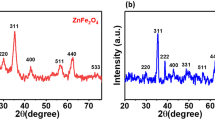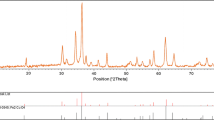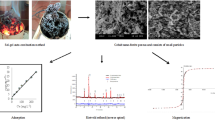Abstract
A series of Cu-substituted NiZn ferrite nanoparticles (Ni0.5Zn0.5-xCuxFe2O4; 0 ≤ x ≤ 0.2) were synthesized by the polyol method and then characterized and investigated for their efficiency for the adsorptive removal of Alizarin Red S (ARS) dye as well as for their reusability. The effect of Cu2+ substitution for Zn2+ on the phase formation, crystal structure, microstructure and magnetic properties was investigated. The powders were pure phases with a cubic spinel structure and a slight departure of the unit cell parameter from the expected linearity variation as a function of Cu2 content. The particles are ultrasmall sized nanoparticles (~4–6 nm) with an almost spherical shape. The surface chemistry and the core local structure of the nanoparticles were ascertained from infrared. Magnetic study revealed a superparamagnetic behavior, and the variation observed for the main magnetic characteristics was interpreted on the basis on the changes in chemical composition, cation distribution and nanoparticles morphology. Adsorption–desorption of ARS onto the nanoparticles was investigated by varying various physicochemical parameters. The ferrite member with x = 0.15 exhibited the best removal capacity. At the optimum pH (pH2.0) the adsorption was fast during the first stage of adsorption process. Three kinetic models were tested. The adsorption data were best fitted with the pseudo-second-order model. The adsorption isotherms were measured and analyzed by Langmuir and Freundlich models. Based on Freundlich model, the maximum adsorption capacity was found to be high (~ 181 mg g−1). Besides, good reusability performance was observed after five adsorption–desorption-regeneration cycles. The mechanisms of both adsorption and desorption were proposed.



















Similar content being viewed by others
Data Availability
All data generated and/or analyzed during this study are included in this published article.
References
Hill, R.J.; Craig, J.R.; Gibbs, G.V.: Systematics of the spinel structure type. Phys. Chem. Miner. 4, 317–339 (1979). https://doi.org/10.1007/BF00307535
Šepelák, V.; Becker, K.D.: Comparison of the cation inversion parameter of the nanoscale milled spinel ferrites with that of the quenched bulk materials. Mater. Sci. Eng. A 375–377, 861–864 (2004). https://doi.org/10.1016/j.msea.2003.10.178
Siddique, M.; Butt, N. M.: Effect of particle size on degree of inversion in ferrites investigated by Mössbauer spectroscopy. Physica B 405, 4211–4215 (2010). https://doi.org/10.1016/j.physb.2010.07.012
Rai, M.; Jamil, B.: Nanotheranostics: Applications and Limitations. Springer, Cham (2019)
Kefeni, K.K.; Mamba, B.B.; Msagati, T.A.M.: Application of spinel ferrite nanoparticles in water and wastewater treatment: a review. Sep. Purif. Technol. 188, 399–422 (2017). https://doi.org/10.1016/j.seppur.2017.07.015
Pang, Y.L.; Lim, S.; Ong, H.C.; Chong, W.T.: Research progress on iron oxide-based magnetic materials: synthesis techniques and photocatalytic applications. Ceram. Int. 42, 9–34 (2016). https://doi.org/10.1016/j.ceramint.2015.08.144
Dar, M.A.; Verma, V.; Gairola, S.P.; Siddiqui, W.A.; Singh, R.K.; Kotnala, R.K.: Low dielectric loss of Mg doped Ni–Cu–Zn nano-ferrites for power applications. Appl. Surf. Sci. 258, 5342–5347 (2012). https://doi.org/10.1016/j.apsusc.2012.01.158
Wu, K.; Li, J.; Zhang, C.: Zinc ferrite based gas sensors: a review. Ceram. Int. 45, 11143–11157 (2019). https://doi.org/10.1016/j.ceramint.2019.03.086
Gubin, S.P. (Ed).: Magnetic Nanoparticles. Wiley, Hoboken (2009). https://doi.org/10.1002/9783527627561
Dong, H.; Chena, Y.C.; Feldmann, C.: Polyol synthesis of nanoparticles: status and options regarding metals, oxides, chalcogenides, and non-metal elements. Green Chem. 17, 4107–4132 (2015). https://doi.org/10.1039/C5GC00943J
Huili, H.; Sophie, N.; Tahar, L.B.: Polyol-made stoichiometric Co0.2Ni0.3Zn0.5Fe2O4 nanoparticles: synthetic optimization, structural, and microstructural studies. Int. J. Nanotechnol. 12, 631–641 (2015). https://doi.org/10.1504/IJNT.2015.068884
Walid, M.; Tahar, L.B.; Patricia, B.; Darine, A.H.; Michel, B.; Olivier, S.; Souad, A.: Polyol-made luminescent and superparamagnetic -NaY0.8Eu0.2F4@γ-Fe2O3 core-satellites nanoparticles for dual magnetic resonance and optical imaging. Nanomaterials 10, 393–410 (2020). https://doi.org/10.3390/nano10020393
Shanker, U.; Rani, M.; Jassal, V.: Degradation of hazardous organic dyes in water by nanomaterials. Environ. Chem. Lett. 15, 623–642 (2017). https://doi.org/10.1007/s10311-017-0650-2
Clarke, E.A.; Anliker, R.: Organic dyes and pigments. In: Anthropogenic Compounds. The Handbook of Environmental Chemistry, vol 3/3A. (1980) Springer, Berlin. https://doi.org/10.1007/978-3-540-38522-6_7
Berradi, M.; Hsissou, R.; Khudhair, M.; Assouag, M.; Cherkaoui, O.; El Bachiri, A.; El Harfi, A.: Textile finishing dyes and their impact on aquatic environs. Heliyon 5, e02711 (2019). https://doi.org/10.1016/j.heliyon.2019.e02711
Córdoba, A.; Magario, I.; Ferreira, M.L.: Experimental design and MM2–PM6 molecular modelling of hematin as a peroxidase-like catalyst in Alizarin Red S degradation. J. Mol. Catal. A: Chem. 355, 44–60 (2012). https://doi.org/10.1016/j.molcata.2011.12.01
Albadarin, A.B.; Mangwandi, C.: Mechanisms of Alizarin Red S and Methylene blue biosorption onto olive stone by-product: isotherm study in single and binary systems. J. Environ. Manage. 164, 86–93 (2015). https://doi.org/10.1016/j.jenvman.2015.08.040
Jeliński, T.; Cysewski, P.: Structure and properties of alizarin complex formed with alkali metal hydroxides in methanol solution. J Mol Model 22, 126–136 (2016). https://doi.org/10.1007/s00894-016-2988-y
Ghaedi, M.; Hassanzadeh, A.; Kokhdan, S.N.: Multiwalled carbon nanotubes as adsorbents for the kinetic and equilibrium study of the removal of alizarin red s and morin. J. Chem. Eng. Data 56, 2511–2520 (2011). https://doi.org/10.1021/je2000414
Gautam, P.K.; Shivapriya, P.M.; Banerjee, S.; Sahoo, A.K.; Samanta, S.K.: Biogenic fabrication of iron nanoadsorbents from mixed waste biomass (MWB) for aqueous phase removal of alizarin red s and tartrazine: kinetics, isotherm and thermodynamic investigation. Environ. Prog. Sustain. Energy 39, 13326 (2019). https://doi.org/10.1002/ep.13326
Tahar, L.B.; Mohamed, H.O.: Fast adsorption-desorption of eriochrome black T using superparamagnetic NiZn ferrite nanoparticles. Desalin. Water Treat. 196, 315–328 (2020). https://doi.org/10.5004/dwt.2020.26039
Prabhat, K.R.; Jechan, L.; Suresh, K.K.; Eilhann, E.K.; Yiu, F.T.; Yong, S.O.; Ki-Hyun, K.: A critical review of ferrate(VI)-based remediation of soil and groundwater. Environ. Res. 160, 420–448 (2018). https://doi.org/10.1016/j.envres.2017.10.016
Liu, K.; Vikrant, B.; Kim, K.; Kumar, V.; Kailasa, S.K.: Critical role of water stability in metal–organic frameworks and advanced modification strategies for the extension of their applicability. Environ. Sci. Nano. 7, 1319–1347 (2020). https://doi.org/10.1039/C9EN01321K
Sedigheh, K.; Neda, A.S.: A comparative study for adsorption of alizarin red s from aqueous samples by magnetic nanoparticles of Fe3O4, CoFe2O4 and ionic liquid-modified Fe3O4. Chem. Methodol. 2:23–38. (2018). https://doi.org/10.22631/chemm.2017.101267.1015
Fu, F.; Gao, Z.; Gao, L.; Li, D.: Effective adsorption of anionic dye, Alizarin Red S, from aqueous solutions on activated clay modified by iron oxide. Ind. Eng. Chem. Res. 50, 9712–9717 (2011). https://doi.org/10.1021/ie200524b
Pirillo, S.; Ferreira, M.L.; Rueda, E.H.: The effect of pH in the adsorption of Alizarin and Eriochrome blue black R onto iron oxides. J. Hazard. Mater. 168, 168–178 (2009). https://doi.org/10.1016/j.jhazmat.2009.02.007
Fan, L.; Zhang, Y.; Li, X.; Lo, C.; Lu, F.; Qiu, H.: Removal of alizarin red from water environment using magnetic chitosan with Alizarin Red as imprinted molecules. Colloids Surf., B 91, 250–257. (2012). https://doi.org/10.1016/j.colsurfb.2011.11.014
Zhang, Z.; Chen, H.; Wu, W.; Pang, W.; Yan, G. :Efficient removal of Alizarin Red S from aqueous solution by polyethyleneimine functionalized magnetic carbon nanotubes. Bioresour. Technol. 293, 122100. (2019). https://doi.org/10.1016/j.biortech.2019.12210
Gholivand, M.B.; Yamini, Y.; Dayeni, M.; Seidi, S.; Tahmasebi, E.: Adsorptive removal of alizarin red-S and Alizarin Yellow GG from aqueous solutions using polypyrrole-coated magnetic nanoparticles. J. Environ. Chem. Eng. 3, 529–540 (2015). https://doi.org/10.1016/j.jece.2015.01.011
Liang, Y.; He, Y.; Zhang, Y.; Zhu Q,: Adsorption property of Alizarin red S by NiFe2O4 /polyaniline magnetic composite. J. Environ. Chem. Eng. 6, 416–425 (2018). https://doi.org/10.1016/j.jece.2017.12.022
Le Bail, A.: Monte Carlo indexing with McMaille. Powder Diffr. 19, 249–254 (2004). https://doi.org/10.1154/1.1763152
Le Bail, A.; Duroy, H.; Fourquet, J.L.: Ab-initio structure determination of LiSbWO6 by X-ray powder (1988)
Langford, J.I.; Wilson, A.J.C.: Scherrer after sixty years: a survey and some new results in the determination of crystallite size. J. Appl. Crystallogr. 11, 102–113 (1978). https://doi.org/10.1107/s0021889878012844
Mohammad, N.; Hoda, S.; Ahmad, H.; Hory, M.: Effect of copper substitution on structural and magnetic properties of NiZn ferrite nanopowders. J. Magn. 18, 391–394 (2013). https://doi.org/10.4283/JMAG.2013.18.4.391
Afzal, A.; Abuilaiwi, F.A.; Javaid, R.; Ali, F.; Habib, A.: Solid-state synthesis of heterogeneous Ni0.5Cu0.5-xZnxFe2O4 spinel oxides with controlled morphology and tunable dielectric properties. J. Mater. Sci.: Mater Electron. 31, 14261–14270 (2020). https://doi.org/10.1007/s10854-020-03982-8
Shannon, R.D.: Revised effective ionic radii and systematic studies of interatomic distances in halides and chalcogenides. Acta Crystallogr. Sect. A: Found. Crystallogr. 32, 751–767 (1976). https://doi.org/10.1107/S0567739476001551
Wei, Q.; Li, J.; Chen, Y.; Han, Y.: Cation distribution in NixMn1−xFe2O4 ferrites. Mater. Chem. Phys. 74, 340–343 (2002). https://doi.org/10.1016/s0254-0584(01)00487-4
StCO, H.; Alexandra, N.: Simple spinels; crystallographic parameters, cation radii, lattice energies, and cation distribution. Am. Mineral. 68, 181–194 (1983)
Pong, W.F.; Chang, Y.K.; Su, M.H.; Tseng, P.K.; Lin, H.J.; Ho, G.H.; Chen, C.T.: Magnetic orientation of Ni in Zn-Ni ferrites studied by soft-x-ray magnetic circular dichroism. Phys. Rev. B: Condens. Matter. 55, 11409–11413 (1997). https://doi.org/10.1103/physrevb.55.11409
Beji, Z.; Smiri, L.S.; Yaacoub, N.; Grenèche, J.M.; Menguy, N.; Ammar, S.; Fiévet, F.: Annealing effect on the magnetic properties of polyol-made Ni−Zn ferrite nanoparticles. Chem. Mater. 22, 1350–1366 (2010). https://doi.org/10.1021/cm901969c
Artus, M.; Tahar, L.B.; Herbst, F.; Smiri, L.; Villain, F.; Yaacoub, N.; Fiévet, F.: Size-dependent magnetic properties of CoFe2O4 nanoparticles prepared in polyol. J. Phys.: Condens. Matter. 23, 506001 (2011). https://doi.org/10.1088/0953-8984/23/50/506001
Hamdeh, H.H.; Hikal, W.M.; Taher, S.M.; Ho, J.C.; Thuy, N.P.; Quy, O.K.; Hanh, N.: Mössbauer evaluation of cobalt ferrite nanoparticles synthesized by forced hydrolysis. J. Appl. Phys. 97, 064310 (2005). https://doi.org/10.1063/1.1856219
Trivedi, B.S.; Jani, N.N.; Joshi, H.H., et al.: Cation distribution of the system CuAlxFe2−xO4 by X-rays and Mossbauer studies. J. Mater. Sci. Science 35, 5523–5526 (2000). https://doi.org/10.1023/A:1004841601270
Tahar, L.B.; Basti, H.; Herbst, F.; Smiri, L.S.; Quisefit, J.P.; Yaacoub, N.; Ammar, S.: Co1−xZnxFe2O4 (0≤x≤1) nanocrystalline solid solution prepared by the polyol method: Characterization and magnetic properties. Mater. Res. Bull. 47, 590–2598 (2012). https://doi.org/10.1016/j.materresbull.2012.080
Makhlouf, S.A.; Parker, F.T.; Berkowitz, A.E.: Magnetic hysteresis anomalies in ferritin. Phys. Rev. B: Condens. Matter. 55, R14717–R14720 (1997). https://doi.org/10.1103/physrevb.55.r14717
Gubin, S.P.; Koksharov, Y.A.; Khomutov, G.B.; Yurkov, G.Y..: Magnetic nanoparticles: preparation, structure and properties. Russ. Chem. Rev. 74, 489–520 (2005). https://doi.org/10.1070/RC2005v074n06ABEH000897
Daliya, S.M.; Ruey, S.J.: An overview of the structure and magnetism of spinel ferrite nanoparticles and their synthesis in microemulsions. Chem. Eng. J. 129, 51–65 (2007). https://doi.org/10.1016/j.cej.2006.11.001
Lu, A.H.; Salabas, E.L.; Ferdi, S.: Magnetic nanoparticles: synthesis, protection, functionalization, and application. Angew. Chem. 46, 1222–1244 (2007). https://doi.org/10.1002/anie.200602866
Shrotri, J.; Kulkarni, S.; Deshpande, C.; Mitra, A.; Sainkar, S.; Anil Kumar, P.; Date, S.: Effect of Cu substitution on the magnetic and electrical properties of Ni–Zn ferrite synthesised by soft chemical method. Mater. Chem. Phys. 59, 1–5 (1999). https://doi.org/10.1016/s0254-0584(99)00019-x
Murthy, N.S.S.; Natera, M.G.; Youssef, S.I.; Begum, R.J.; Srivastava, C.M.: Yafet-Kittel angles in zinc-nickel ferrites. Phys. Rev. S. 181, 969–977 (1969). https://doi.org/10.1103/physrev.181.969
Demortière, A.; Panissod, P.; Pichon, B.P.; Pourroy, G.; Guillon, D.; Donnio, B.; Bégin-Colin, S.: Size-dependent properties of magnetic iron oxide nanocrystals. Nanoscale 3, 225–232 (2011). https://doi.org/10.1039/c0nr00521e
Ortega, D.; Fort, E.V.; Garcia, D.A.; Garcia, R.; Litrán, R.; Barrera-Solano, C.; Del-Solar, M.R.: Domínguez, M.: Size and surface effects in the magnetic properties of maghemite and magnetite coated nanoparticles. Philos. Trans. R. Soc. London, Ser. A 368:4407–4418 (2010). https://www.jstor.org/stable/20752670
Gilleo, M.A.: Superexchange interaction in ferrimagnetic garnets and spinels which contain randomly incomplete linkages. J. Phys. Chem. Solids 13, 33–39 (1960). https://doi.org/10.1016/0022-3697(60)90124-4
Guat, T.T.; Xie, Y.G.; Wai, F.Y.: Adsorption of pollutants in wastewater via biosorbents, nanoparticles and magnetic biosorbents: a review. Environ. Res. 212(Part B), 113248 (2022). https://doi.org/10.1016/j.envres.2022.113248
Santander, P.; Oyarce, E.; Sánchez, J.: New insights in the use of a strong cationic resin in dye adsorption. Water Sci. Technol. 81, 773–780 (2020). https://doi.org/10.2166/wst.2020.158
Ravindra, K.G.; Sushmita, B.; Pavan, K.G.; Vandani, R.; Ajay, K.; Sanjeev, K.S.; Chattopadhyaya, M.C.: Biosorption of an acidic dye, alizarin red s, onto biosorbent of mustard husk: kinetic, equilibrium modeling and spectroscopic analysis. AJRC. 7, 415–425 (2014)
Tahar, L.B.; Oueslati, M.H.; Grindi, B.: A comparative study of two CoZn nanoferrites: preparation, characterization, magnetic properties, Cr(VI) removal and regeneration. Desalin. Water Treat. 144, 243–256 (2019). https://doi.org/10.5004/dwt.2019.23682
Tahar, L.B.; Oueslati, M.H.; Abualreish, M.J.A.: Synthesis of magnetite derivatives nanoparticles and their application for the removal of chromium (VI) from aqueous solutions. J. Colloid Interface Sci. 512, 115–126 (2018). https://doi.org/10.1016/j.jcis.2017.10.044
Thanaa, I.S.; Marwa, F.E.K.; Abd, E.M.Z.; Soheir, M.E.K.: Preparation and application of magnetite nanoparticles immobilized on cellulose acetate nanofibers for lead removal from polluted water. Water Supply 17, 176–187 (2017). https://doi.org/10.2166/ws.2016.124
Sahoo, T.R.; Prelot, B.: Adsorption processes for the removal of contaminants from wastewater. Nanomaterials for the detection and removal of wastewater pollutants, pp. 161–222. In: Barbara B, Francesca SF, Rajandrea S. (ed) Nanomaterials for the Detection and Removal of Wastewater Pollutants. Micro and Nano Technologies. Elsevier, Amsterdam, pp. 161–222. (2020). https://doi.org/10.1016/b978-0-12-818489-9.00007-4
Cheung, C.; Porter, J.; Mckay, G.: Sorption kinetic analysis for the removal of cadmium ions from effluents using bone char. Water Res. 35, 605–612 (2001). https://doi.org/10.1016/s0043-1354(00)00306-7
Mohan, D.; Pittman, C.U.: Activated carbons and low cost adsorbents for remediation of tri- and hexavalent chromium from water. J. Hazard. Mater. 137, 762–811 (2006). https://doi.org/10.1016/j.jhazmat.2006.06.060
Alkaram, U.F.; Mukhlis, A.A.; Al-Dujaili, A.H.: The removal of phenol from aqueous solutions by adsorption using surfactant-modified bentonite and kaolinite. J. Hazard. Mater. 169, 324–332 (2009). https://doi.org/10.1016/j.jhazmat.2009.03.153
Jiang, J.Q.; Cooper, C.; Ouki, S.: Comparison of modified montmorillonite adsorbents. Chemosphere 47, 711–716 (2002). https://doi.org/10.1016/s0045-6535(02)00011-5
Agboola, O.D.; Benson, N.U.: Physisorption and chemisorption mechanisms influencing micro (nano) plastics-organic chemical contaminants interactions: a review. Front. Environ. Sci. 9, 678574 (2021). https://doi.org/10.3389/fenvs.2021.678574
Shen, L.; Laibinis, P.E.; Hatton, T.A.: Bilayer surfactant stabilized magnetic fluids: synthesis and interactions at interfaces. Langmuir 15, 447–453 (1999). https://doi.org/10.1021/la9807661
Yang, K.; Peng, H.; Wen, Y.; Li, N.: Re-examination of characteristic FTIR spectrum of secondary layer in bilayer oleic acid-coated Fe3O4 nanoparticles. Appl. Surf. Sci. 256, 3093–3097 (2010). https://doi.org/10.1016/j.apsusc.2009.11.079
Moriguchi, T.; Yano, K.; Nakagawa, S.; Kaji, F.: Elucidation of adsorption mechanism of bone-staining agent alizarin red S on hydroxyapatite by FT-IR microspectroscopy. J. Colloid Interface Sci. 260, 19–25 (2003). https://doi.org/10.1016/s0021-9797(02)00157-1
Basti, H.; Tahar, L.B.; Smiri, L.S.; Herbst, F.; Vaulay, M.-J.; Chau, F.; Benderbous, S.: Catechol derivatives-coated Fe3O4 and γ-Fe2O3 nanoparticles as potential MRI contrast agents. J. Colloid Interface Sci. 341, 248–254 (2010). https://doi.org/10.1016/j.jcis.2009.09.043
Acknowledgements
The authors are greatly indebted to the deanship of Scientific Research at Northern Border University for its funding of the present research work through the research project No. SCIA-2022-11-1528.
Funding
This work was supported by the deanship of Scientific Research at Northern Border University through the research project No. SCIA-2022–11-1528.
Author information
Authors and Affiliations
Corresponding author
Ethics declarations
Conflict of interest
On behalf of all authors, the corresponding author states that there is no conflict of interest.
Supplementary Information
Below is the link to the electronic supplementary material.
Rights and permissions
Springer Nature or its licensor (e.g. a society or other partner) holds exclusive rights to this article under a publishing agreement with the author(s) or other rightsholder(s); author self-archiving of the accepted manuscript version of this article is solely governed by the terms of such publishing agreement and applicable law.
About this article
Cite this article
Mogharbel, R., Tahar, L.B., Huili, H. et al. Ultrasmall Cu-Substituted NiZn Ferrite Nanoparticles: Efficiency for the Removal of the Alizarin Red S Dye and Reusability. Arab J Sci Eng 49, 311–337 (2024). https://doi.org/10.1007/s13369-023-08107-x
Received:
Accepted:
Published:
Issue Date:
DOI: https://doi.org/10.1007/s13369-023-08107-x




